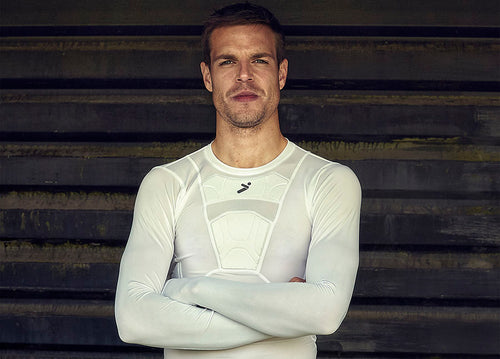Le rituel du taping d'avant-match apporte un soutien indispensable à certaines des articulations les plus susceptibles de se blesser en tant que gardien de but. Les méthodes varient et les résultats ne sont pas toujours probants. C'est pourquoi nous avons demandé à Stefan Frei, joueur étoile, de nous expliquer sa technique.
Voici notre guide étape par étape sur les techniques de pose de bandes sur les doigts pour que vous puissiez scotcher vos doigts comme un pro :
Comment scotcher les doigts
Les gardiens de but ne sont pas étrangers aux blessures aux doigts. Stef Frei le sait : "... cela fait partie du jeu. Je pense que j'ai disloqué ou cassé à peu près tous mes doigts et ce n'est pas amusant". La FIFA affirme que "le risque de blessure n'est jamais très loin de l'homme qui porte le maillot numéro 1". Alors que pouvons-nous faire, en tant que gardiens de but, pour éviter l'infirmerie et rester sur le terrain ?

Comme l'utilisation de épines des doigts dans les gantsles bandes pour les doigts ajoutent de la stabilité et réduisent le risque de blessures aux doigts. Lors de notre dernière visite au centre d'entraînement des Seattle Sounder, Starfire, Stef nous a montré comment il scotchait ses doigts avant les grands matchs. "Il y a quelques années, j'ai fait des recherches en ligne et j'ai trouvé de bonnes vidéos de combattants de l'UFC sur la façon dont ils scotchent leurs doigts... J'ai pu trouver des informations précieuses...".
En utilisant la routine de Stef et quelques influences du Jiu Jitsu, voici notre technique recommandée pour scotcher les doigts.

1. Utilisez un rouleau de ruban adhésif médical ou athlétique de 1/2" d'épaisseur et commencez par faire un tour complet autour de la base de votre doigt.



4. Ramenez le ruban en diagonale vers la base, en créant un X qui se croise au niveau de l'articulation centrale.

5. Réalisez un dernier enroulement autour de la base et coupez l'excédent de ruban si nécessaire.
En tant que gardien, il est important de protéger vos doigts, mais il est tout aussi important de conserver l'amplitude de vos mouvements. Avec cette technique, "....Je pouvais plier mes doigts de la manière dont j'en avais besoin et non de manière à me blesser".
Comment envelopper le poignet
Bien que la plupart des gants soient désormais dotés de sangles de poignet plus épaisses, celles-ci n'offrent souvent pas le soutien nécessaire aux gardiens de compétition. Lorsqu'il est effectué correctement, le bandage du poignet peut être un excellent moyen de compléter ce soutien. Frei a également proposé ses méthodes pour ce rituel :

1. Utilisez un rouleau de ruban adhésif médical ou athlétique de 2 pouces de large et commencez par placer le bord du ruban sur votre poignet. L'extrémité du ruban doit se trouver juste au-dessus de l'endroit où votre poignet se plie.

2. Faites deux ou trois tours complets autour de votre poignet et coupez le ruban.

3. Pour plus de soutien, répétez l'opération en passant entre le pouce et l'index. Terminez par un tour supplémentaire autour du poignet (facultatif).
Stef nous dit : "Il s'agit de faire tout ce qui est en notre pouvoir pour minimiser les blessures et ma technique d'application du ruban adhésif nous a aidés à nous protéger un peu plus". Ce rituel est à l'origine de notre Legend Glove double longueur de notre gant Legend.
C'est un emballage.
Coécrit par Stef Frei et Sebastian Head.























